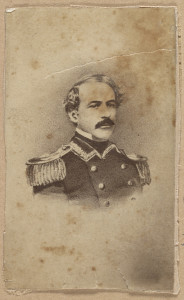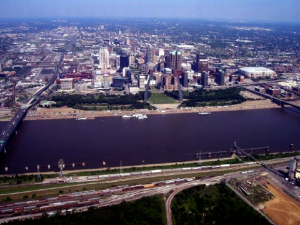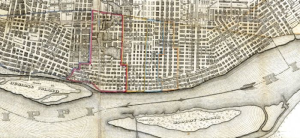
The Mississippi as the key to commerce
Even if the Civil War never happened, and even if Robert E. Lee never became president of Washington and Lee University, we would still probably know him today. He changed American history not only as a general and university administrator, but as an engineer. His most celebrated engineering feat? He made the Mississippi River navigable.
Let’s put that feat into perspective.

If you were a Midwest farmer in the 1830s, you’d need to find people to buy your harvest. Who would that be? Certainly not the folks from the next farm over. Before the era of the railroad, canals and inland waterways were the main types of transportation for transferring produce to the places where people needed them the most: the cities. As farmers moved further west, the Mississippi played an increasingly significant role. As Michael Korda wrote, “The great river that Indians called the ‘Father of the Waters’ was then America’s most important path of trade and communication, linking the grain of the Northwest and the cotton of the upper Mississippi with the thriving port of New Orleans…. It is hard to exaggerate the importance of these problems in the age before decent roads or railways existed in what is now the Midwest – goods in bulk moved by river or did not move at all.”
St. Louis was the major harbor for the Midwest. But that suddenly changed in the 1830s. Changing currents began to deposit silt in the St. Louis harbor, choking it and blocking shipping.
Robert E. Lee tames the Mississippi
The army sent Lee to St. Louis in 1837 to solve the problems. Lee had been working with the Army Corps of Engineers since graduating second in his class at West Point in 1829.

Lee’s genius was his ability to work with the river, not against it. Better than digging out a harbor is go to upstream and figure out how to lay new switches and alter the current. Lee figured out a way to let the water do the hard work. Directly upstream, he constructed two dykes off the points of the mile-long Bloody Island, blocking the current on the Illinois side and diverting it to St. Louis. By the end of the construction season, the channel to the harbor had already deepened by seven feet, allowing boats to enter again.
As Michael Korda notes, this engineering feat would have earned Robert E. Lee fame and the gratitude of the Midwest even if it weren’t for his military achievements. He opened the Mississippi to hundreds of steamboats and made the Midwest the granary of North America. That is a fitting tribute for today. January 19 is Robert E. Lee’s birthday.
What do you think the country’s greatest engineering feat was? I’ll vote for putting men on the moon.
Literature on point:
Douglas Southall Freeman, R. E. Lee (New York: Charles Scribner’s Sons 1934)
Michael Korda, Clouds of Glory: The Life of Robert E. Lee (Harper 2014)



Greatest engineering feat: getting men back safe from the moon.
I knew “Bloody Island” had to have a story behind it! Many duels were held there (including one with Abraham Lincoln)
You’re right, Brian. Getting men back from the moon might have been more difficult than getting them there!
I loved learning this, Ann Marie. One of my grandfathers was a Missouri farmer and a surveyor. We lived an hour away from the Mississippi, but it had a big presence in my childhood. Now, I drive along the Susquehanna River in Pennsylvania to visit family and remember the key role the big wide rivers had in connecting places and products. Also, unfortunately, the avenues for military force.
Thanks, Elaine! It’s all too easy to forget the historical importance of rivers and that Robert E. Lee contributed more to American history than just war.
Hi, Anne Marie. Thanks for an interesting post! It reminded me that Robert E. Lee also studied the rapids near Keokuk, in the southeast corner of Iowa.
Thanks, David, for your comment. Keokuk is a little piece of trivia I didn’t know, but it underscores the point that Robert E. Lee did more for the nation than just fight in the Civil War!
There was more to Robert E. Lee than the years of 1861 to 1865. His involment in engineering is an interesting read.
I agree, Reon. That’s one of the reasons I wrote this post! History has a tendency to view Lee through Civil War-colored glasses.
Thank you so much, Ann Marie, for your writings and sharing with us. Valuable history.
You’re welcome, Irma, and thanks for commenting!
Well done Anne Marie. If not mistaken, Lee was responsible for the construction of more than a couple of military installations during his duty. Memory is not that good! Civil Engineers today say that the Hoover Dam was no. 1…..for civil engineering. A Gentleman and a scholar. Thanks Anne Marie for sharing.
Yes, he was. He did work on military installations in Virginia and New York. In this day and age of disparaging Confederate generals, it’s important to see their good sides, too. A Northerner who can’t understand why Virginians would follow Lee and venerate him can’t really understand the war, regardless of whether his statues are still standing or not. And even if most Americans don’t support the Confederacy, we can at least salute Lee for the work he did outside of the Civil War. Thanks for commenting, Lee.
So Lee help the north become the powerhouse the would defeat the so called Confederacy.
That’s an interesting insight. He helped the Midwest, at least, and that could have cut both ways.